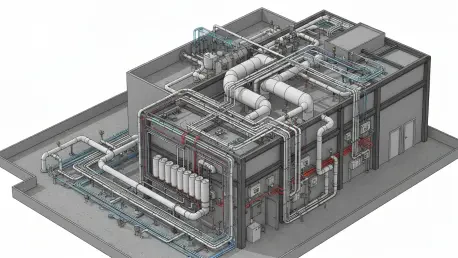In the fast-evolving world of construction and design, mechanical, electrical, and plumbing (MEP) professionals in the UK face mounting pressure to deliver projects with precision, speed, and compliance with stringent local standards. Amid tight deadlines and complex requirements, the integration of advanced software solutions into familiar platforms has become a game-changer for streamlining workflows. Trimble, a leader in construction technology, has introduced a powerful tool that enhances Autodesk AutoCAD, a staple in the UK MEP sector, by embedding intelligent features tailored for mechanical design. This innovative solution bridges the gap between traditional drafting and modern Building Information Modeling (BIM), promising to redefine how engineers and contractors approach their projects. As the industry shifts toward automation and interoperability, this development offers a glimpse into a future where efficiency and accuracy are no longer aspirations but everyday realities for design professionals.
Elevating Design Efficiency and Precision
Streamlining Workflows with Automation
For MEP designers in the UK, time-consuming manual tasks have long been a bottleneck in project delivery, often leading to delays and errors that ripple through the construction process. A transformative software enhancement for AutoCAD now automates critical functions such as calculations, tagging, and the modeling of intricate connections, significantly reducing the hours spent on repetitive work. This automation ensures that documentation updates dynamically with every design change, eliminating the need for tedious manual revisions and fostering seamless communication across teams. By transforming a familiar platform into a sophisticated design tool, this solution empowers mechanical engineers to focus on creativity and problem-solving rather than routine drafting. The result is a marked increase in productivity, allowing projects to move forward faster while maintaining high standards of quality. This shift is particularly impactful in an industry where meeting deadlines without compromising on detail is a constant challenge.
Enhancing Accuracy through Intelligent Modeling
Beyond saving time, achieving precision in MEP design is paramount to avoiding costly mistakes during construction, and this software upgrade delivers on that front with remarkable capabilities. It introduces intelligent detailing that enables the creation of data-rich 3D models, offering enhanced visibility into complex systems before they are built. These models help identify potential conflicts early in the design phase, reducing the likelihood of rework and ensuring smoother project execution. Furthermore, with a UK-specific engine and centralized standards management, compliance with local regulations becomes an integrated part of the workflow rather than an afterthought. Compared to traditional manual methods, this approach minimizes the risk of non-compliance and associated penalties, providing designers with confidence in their output. The emphasis on accuracy not only elevates the quality of designs but also strengthens trust among stakeholders, as errors are caught and corrected long before they become real-world problems.
Fostering Collaboration and Industry Alignment
Breaking Down Barriers with Seamless Integration
Collaboration across platforms and disciplines is a cornerstone of modern construction, yet data silos and compatibility issues often hinder effective teamwork in MEP projects. A standout feature of this AutoCAD enhancement is its direct integration with Revit, enabling designs to be shared and edited across platforms without loss of critical information. This interoperability supports fluid transitions within BIM and Industry Foundation Classes (IFC) ecosystems, ensuring that mechanical designs align with broader project requirements. By breaking down barriers between tools, the software facilitates multidisciplinary coordination, allowing teams to work cohesively even when using different systems. Access to an extensive library of real-world manufacturer components further ensures that designs remain accurate and relevant to current standards. This focus on integration reflects a commitment to meeting the collaborative demands of today’s construction landscape, where teamwork is as vital as technical expertise.
Responding to Market Needs and Standards
The construction industry’s ongoing shift toward technology-driven solutions underscores the need for tools that balance innovation with familiarity, especially in markets like the UK where AutoCAD remains a dominant platform. This software enhancement was developed in response to customer feedback and evolving market demands, ensuring it addresses real-world challenges faced by mechanical designers. As noted by industry leaders at Trimble, the goal is not to replace trusted tools but to augment them with intelligent features that enhance precision and efficiency. Tailored specifically for mechanical design in the UK, the solution aligns with local standards while incorporating modern BIM requirements, offering a targeted approach to industry needs. This balance of legacy compatibility and forward-thinking functionality positions it as a vital asset for professionals aiming to stay competitive. By meeting designers where they are and elevating their capabilities, it supports a seamless transition into the future of construction technology.
Reflecting on a Milestone for MEP Innovation
Looking back, Trimble’s introduction of this powerful enhancement for AutoCAD marked a pivotal moment for MEP professionals in the UK, delivering a tool that redefined the potential of a familiar platform. It addressed critical pain points by automating workflows, ensuring precision through intelligent modeling, and fostering collaboration via seamless integration with other systems. The alignment with UK-specific standards provided an added layer of reassurance, reducing risks and enhancing project outcomes. For many in the industry, this development stood as a testament to the power of technology to transform even the most established tools into engines of innovation. As a next step, professionals were encouraged to explore how such solutions could be integrated into their existing processes, leveraging training and support to maximize benefits. Looking ahead, the focus should remain on adopting interoperable, automated tools that anticipate future challenges, ensuring that the UK MEP sector continues to thrive in an increasingly complex construction environment.









